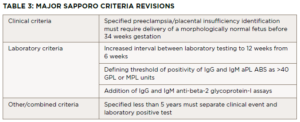The clinical criteria include one or more episodes of venous, arterial or small vessel thrombosis within any tissue or organ confirmed with unequivocal imaging or histopathology. The second clinical criterion is pregnancy morbidity, with three subsets of situations included. The first is the occurrence of one or more unexplained deaths of a morphologically normal fetus at or beyond the 10th week of gestation. Normality of the fetus must be confirmed by ultrasound or direct examination. The second includes one or more premature births of a normal neonate before the 34th week of gestation. This premature birth can be due to severe preeclampsia, eclampsia or placental insufficiency. The third is three or more unexplained, consecutive, spontaneous abortions before the 10th week of gestation.
Three laboratory criteria exist. First is the presence of lupus anticoagulant in plasma on two or more occasions at least 12 weeks apart. The second and third criteria are the presence of anti-cardiolipin and beta-2 glycoprotein-I antibodies respectively, (IgG or IgM isotypes) on two or more occasions at least 12 weeks apart. Miyakis et al. discussed the inclusion of skin manifestations such as livedo reticularis as independent criteria for diagnosis, but due to a lack of specificity this was rejected.2 Digital gangrene did not merit inclusion because it was considered rare.2
Treatment
The treatment of APS can be divided into primary and secondary thromboprophylaxis. Primary thromboprophylaxis is considered for aPL-positive patients who have not yet had a thrombotic event. The aim of treatment is reducing vascular risk factors, including hypercholesterolemia, obesity, smoking and use of estrogen-containing contraceptives. Although not guideline therapy, patients with high aPL titers or positivity of multiple APS-associated ABS can be treated with low-dose aspirin daily.4 Hydroxychloroquine and aspirin can be considered in patients with concomitant SLE, as well as in primary APS, because it has been demonstrated to reduce thrombosis. Statins also have proven anti-thrombotic efficacy in patients with and possible without hyperlipidemia.
Pregnant women without thrombotic events can be managed with low-dose aspirin and prophylactic-dose low molecular weight heparin (LMWH). Aspirin can also be used in the preconception period because it has been shown to aid implantation.
Secondary thromboprophylaxis is recommended for patients with proven thrombotic events. Venous thrombosis is treated in the acute setting with unfractionated heparin or LMWH, followed by chronic use of anticoagulation for a goal international normalized ratio (INR) of 2.0–3.0. Direct oral anticoagulants have not been shown to have comparable efficacy in this condition.5

